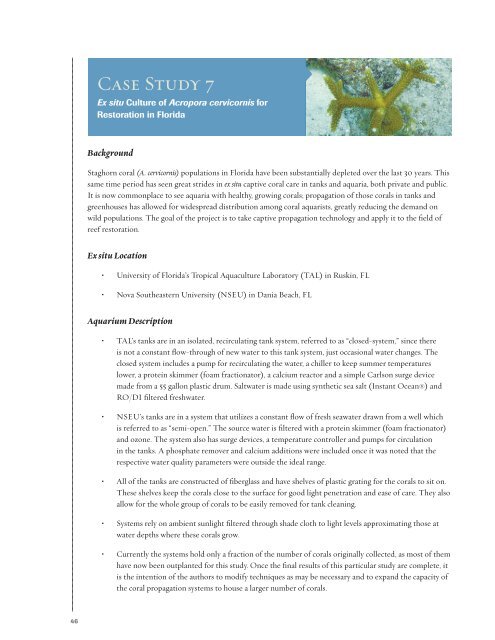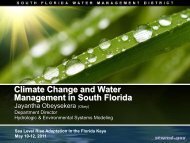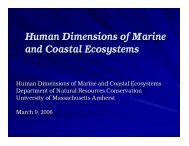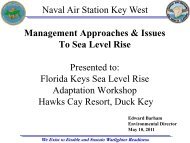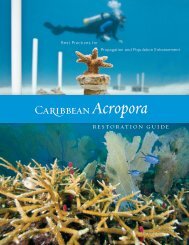Caribbean Acropora Restoration Guide - The Florida Reef ...
Caribbean Acropora Restoration Guide - The Florida Reef ...
Caribbean Acropora Restoration Guide - The Florida Reef ...
Create successful ePaper yourself
Turn your PDF publications into a flip-book with our unique Google optimized e-Paper software.
Case Study 7<br />
Ex situ Culture of <strong>Acropora</strong> cervicornis for<br />
<strong>Restoration</strong> in <strong>Florida</strong><br />
Background<br />
Staghorn coral (A. cervicornis) populations in <strong>Florida</strong> have been substantially depleted over the last 30 years. This<br />
same time period has seen great strides in ex situ captive coral care in tanks and aquaria, both private and public.<br />
It is now commonplace to see aquaria with healthy, growing corals; propagation of those corals in tanks and<br />
greenhouses has allowed for widespread distribution among coral aquarists, greatly reducing the demand on<br />
wild populations. <strong>The</strong> goal of the project is to take captive propagation technology and apply it to the field of<br />
reef restoration.<br />
Ex situ Location<br />
• University of <strong>Florida</strong>’s Tropical Aquaculture Laboratory (TAL) in Ruskin, FL<br />
• Nova Southeastern University (NSEU) in Dania Beach, FL<br />
Aquarium Description<br />
• TAL’s tanks are in an isolated, recirculating tank system, referred to as “closed-system,” since there<br />
is not a constant flow-through of new water to this tank system, just occasional water changes. <strong>The</strong><br />
closed system includes a pump for recirculating the water, a chiller to keep summer temperatures<br />
lower, a protein skimmer (foam fractionator), a calcium reactor and a simple Carlson surge device<br />
made from a 55 gallon plastic drum. Saltwater is made using synthetic sea salt (Instant Ocean®) and<br />
RO/DI filtered freshwater.<br />
• NSEU’s tanks are in a system that utilizes a constant flow of fresh seawater drawn from a well which<br />
is referred to as “semi-open.” <strong>The</strong> source water is filtered with a protein skimmer (foam fractionator)<br />
and ozone. <strong>The</strong> system also has surge devices, a temperature controller and pumps for circulation<br />
in the tanks. A phosphate remover and calcium additions were included once it was noted that the<br />
respective water quality parameters were outside the ideal range.<br />
• All of the tanks are constructed of fiberglass and have shelves of plastic grating for the corals to sit on.<br />
<strong>The</strong>se shelves keep the corals close to the surface for good light penetration and ease of care. <strong>The</strong>y also<br />
allow for the whole group of corals to be easily removed for tank cleaning.<br />
• Systems rely on ambient sunlight filtered through shade cloth to light levels approximating those at<br />
water depths where these corals grow.<br />
• Currently the systems hold only a fraction of the number of corals originally collected, as most of them<br />
have now been outplanted for this study. Once the final results of this particular study are complete, it<br />
is the intention of the authors to modify techniques as may be necessary and to expand the capacity of<br />
the coral propagation systems to house a larger number of corals.<br />
46


